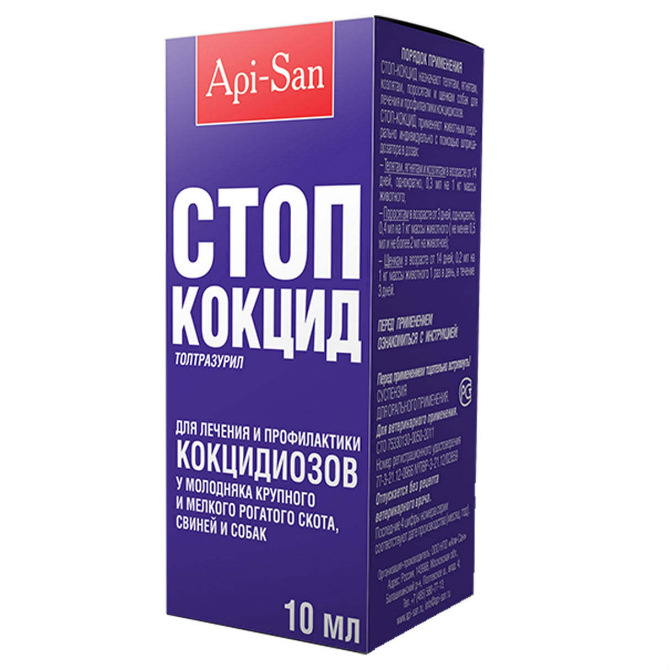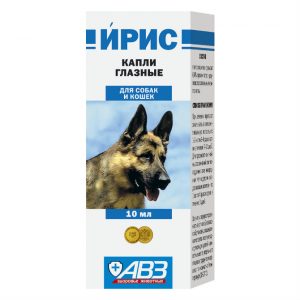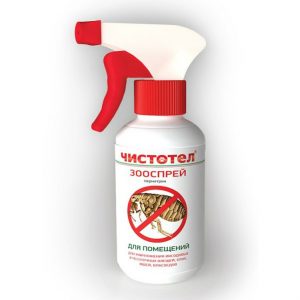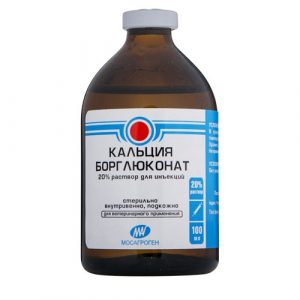Description
Pharmacological action of
Stop coccid belongs to the antioxidant group of the triazintrione group.
Toltrazuril, which is part of the drug, has a wide spectrum of coccidiocidal action at the stages of intracellular development of parasites, is effective against all types of coccidia, including Eimeria spp., Isospora spp., Cistoisospora spp., parasitizing in piglets, calves, lambs, rabbits, puppies of dogs and fur animals.
Toltrazuril has a damaging effect on mitochondria and the processes of fission of the coccidia nucleus, disrupting the formation of macrogametocytes, blocking respiratory enzymes, and causing death of parasites.
After oral administration of the drug, toltrazuril is slowly absorbed and has a coccidiocidal effect on the mucous and submucous membranes of the gastrointestinal tract.
In the body, toltrazuril is metabolized by sulfoxidation and hydroxylation, with the formation of sulfoxide and sulfone.
It is excreted mainly in an unchanged form – up to 70%, as well as in the form of metabolites with feces and partially with urine.
Stop coccid according to the degree of exposure to the body refers to low-hazard substances (hazard class 4 according to GOST 12.1.007-76), in recommended doses, it does not cause side effects and complications in animals, does not prevent the formation of immunity to coccidiosis.
Indications
Stop coccid is prescribed to calves, lambs, kids, piglets, rabbits, puppies of dogs and fur animals for the treatment and prevention of coccidiosis.
Contraindications
Contraindication to the use of Stop Coccid is an increased individual sensitivity of the animal to the components of the drug, serious impairment of liver and / or kidney function.
Do not use the drug in adult ruminants with advanced cicatricial digestion.
Special instructions
There are no specific effects of the drug during its first use and withdrawal.
Pregnant females, if necessary, the drug is used after consultation with a veterinarian in the second half of pregnancy. The drug is not intended for use by dairy animals.
Violations of the regimen of the drug should be avoided, as this may lead to a decrease in its effectiveness. In case of skipping the next dose, the drug must be administered as soon as possible in the same dose, then the interval between injections of the drug does not change.
When using Stop-coccid in accordance with this instruction, side effects and complications in animals, as a rule, are not observed. With increased individual sensitivity to the drug and the appearance of allergic reactions, the animal is prescribed antihistamines and symptomatic therapy.
Stop coccid should not be used concurrently with other anti-coccidia drugs. There is no evidence of drug incompatibility with drugs of other groups and feed additives.
Slaughter of calves, lambs, kids and rabbits for meat is allowed no earlier than 63 days, piglets – no earlier than 70 days after the application of Stop-coccid. Meat of animals forced to kill previously established deadlines can be used to feed fur animals.
Composition
Stop coccid in 1 ml contains toltrazuril – 50 mg as an active ingredient, as well as excipients: sodium benzoate, potassium sorbate, croscarmellose sodium, asasvit C 200, lactose, tween-80, aerosil, propylene glycol, xanthan gum , citric acid, dimethicone and purified water.
Dosage and administration
Stop coccid is administered individually to animals orally with a dosing syringe or mixed with a small amount of feed. In case of sediment, the container with suspension should be thoroughly shaken before use.
Doses and dosage regimens are presented in the table.
Table
Type of animal
Age
Dose of the drug per 1 kg of animal weight
Frequency and duration of the drug
AI, mg / kg
suspension, ml / kg
Calves, lambs and goats
from 14 days
from 15 days
once
Pigs
from 3 days
20
0.4 (not less than 0.5 and not more than 2 ml / animal)
once
puppies of dogs
from 14 days
10
0.2
once a day, 3 consecutive days
Rabbits
from 28 days 7 0.14 Once
Minks
from 28 days 20 0.4 Once
Arctic foxes
from 28 days 10 0.2 One-time
Unfortunate s of coccidiosis farms to achieve maximum preventive effect and reduce the number of oocysts allocated to the external environment, the drug should be prescribed to susceptible animals until the first clinical signs of the disease appear in the herd.
Overdose of
With an overdose of the drug, the animal may experience a decrease in appetite, a decrease in water consumption, an upset gastrointestinal tract, and vomiting.
dosage form
suspension for oral administration




